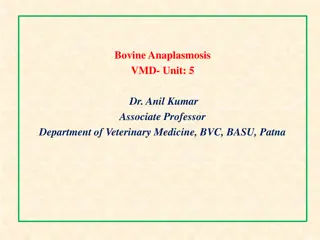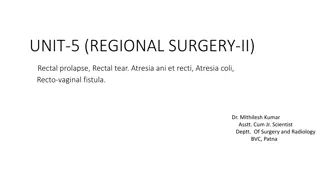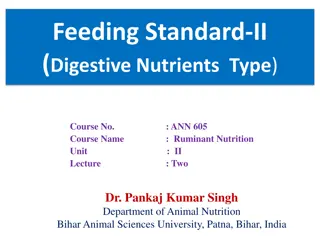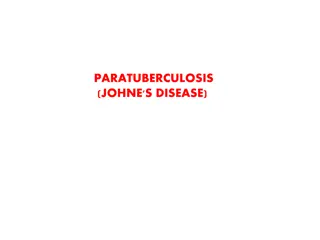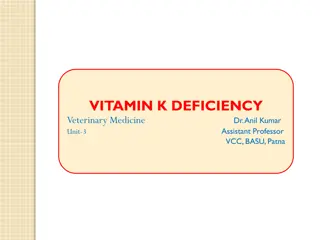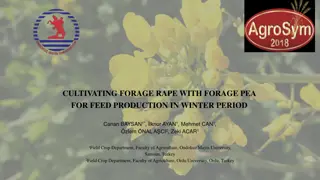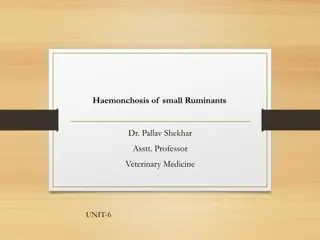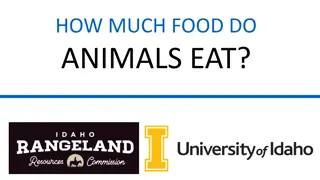Feed Software Market
Feed Software Market by Type (Feed Formulation, Animal Simulation Model), Deployment Mode (On-premise, Cloud-based Software), Animal Type (Poultry, Ruminants, Aquaculture, Pet), End User (Feed Manufacturers, Animal Farmers) - Global Forecast to 2030\n
0 views • 2 slides
Understanding Bovine Anaplasmosis: Causes, Symptoms, and Management
Bovine anaplasmosis is an infectious disease in ruminants caused by Anaplasma species transmitted by ticks. This article covers the etiology, host susceptibility, transmission methods, symptoms, and life cycle of the disease. It highlights the age-related susceptibility in cattle and provides insigh
6 views • 10 slides
Feed Additives Market - Global Opportunity Analysis and Industry Forecast (2023-
Feed Additives Market by Type (Performance Additives, Specialty Additives), Animal Type (Poultry, Ruminants, Swine, Aquatic Animals), Source (Synthetic, Natural), Form (Dry, Liquid), and Geography - Global Forecast to 2030\n
4 views • 3 slides
Anatomy of Intestine in Domestic Animals
The intestine in domestic animals plays a vital role in digestion and absorption. It consists of the small intestine for chemical digestion and absorption and the large intestine for water absorption and excretion. This article covers the gross anatomy, histology, and embryology of the intestine, de
2 views • 84 slides
Veterinary Parasitology: Liver Fluke Questions and Matching Scenarios
Explore a series of questions and matching scenarios related to liver fluke infections in ruminants, focusing on Fasciola hepatica and related helminth diseases. Discover clinical signs, associations, and key details encompassing different parasitic worms and their impact on animal health.
0 views • 11 slides
Rectal Prolapse and Rectal Tears in Animals: Causes and Treatments
Rectal prolapse and rectal tears are common conditions observed in cattle, buffaloes, and small ruminants. Prolonged tenesmus, increased intraabdominal pressure, rectal inflammation, and other factors contribute to the development of these issues. Early diagnosis and treatment are crucial to prevent
2 views • 34 slides
Protein Digestion and Metabolism in Ruminants and Non-Ruminants
Digestion and metabolism of protein in both ruminants and non-ruminants involve enzymatic breakdown of proteins into polypeptides and amino acids in the stomach and intestines. Key enzymes such as pepsin, trypsin, and chymotrypsin play important roles in protein digestion. Gastric digestion in the s
3 views • 14 slides
Establishing Safety Standards in Non-Movement Areas at Smith Reynolds Airport
This guide outlines the purpose, definitions, rules, and safety measures for operating vehicles in non-movement areas at Smith Reynolds Airport. It emphasizes standardized ground movement practices to ensure the safety of airport patrons, reduce the risk of injury, and maintain a high level of safet
1 views • 12 slides
Overview of Superfamilies in Order Strongylida Nematodes
The Order Strongylida in nematodes encompasses four main superfamilies - Trichostrongyloidea, Strongyloidea, Ancylostomoidea, and Metastrongyloidea. Each superfamily is defined by distinct characteristics such as buccal cavity size and location within the host, as well as differences in life cycle a
1 views • 34 slides
Understanding Rinderpest: Symptoms, Transmission, and Host Range
Rinderpest is a viral disease characterized by high fever, lachrymal discharge, inflammation, erosions of the mouth, and diarrhea, leading to death. The disease affects cloven-hoofed animals, with cattle and water buffalo being most susceptible. Transmission occurs through aerosol vectors and ingest
0 views • 60 slides
Understanding Amphistomosis in Ruminants: Causes, Symptoms, and Diagnosis
Amphistomosis is a disease in ruminants caused by several types of rumen flukes. It leads to productivity losses, weight loss, fertility reduction, and other symptoms. Infection occurs through ingestion of contaminated vegetables and raw meat. The parasite affects the rumen and reticulum of sheep, g
0 views • 8 slides
Understanding Non-Aqueous Solvents: Types and Classification
Inorganic non-aqueous solvents play a crucial role in chemical research and industry. This article by Dr. Princy K.G. delves into the classification of solvents based on protonicity, polarity, and aqueous vs. non-aqueous nature. It explores the types of non-aqueous solvents, such as protonic and non
1 views • 29 slides
Understanding Johne's Disease in Ruminants: Causes, Transmission, and Clinical Findings
Johne's Disease, caused by Mycobacterium paratuberculosis, is a chronic bacterial infection affecting the lower intestinal tract of ruminants. It is characterized by chronic diarrhea and emaciation, mainly seen in mature animals. The mode of transmission includes contaminated food/water, intrauterin
0 views • 12 slides
Understanding Vagal Indigestion in Ruminants: Causes and Types
Vagal indigestion in ruminants is a functional disturbance affecting the fore stomachs, leading to symptoms like rumen distention, inappetence, bradycardia, and more. It is not a specific disease but a syndrome with various underlying causes such as injury, inflammation, or mechanical obstruction. T
1 views • 14 slides
Understanding Non-Firm Quantities in Electricity Markets
Non-Firm Quantities in electricity markets involve units with non-firm access not being compensated for their non-firm capacity not getting accommodated on the system. The concept of Firm Access Quantity plays a key role in determining compensation levels for units, with differences in implementatio
0 views • 6 slides
Overview of Antitubercular Drugs: Introduction, Classification, and Applications
Tuberculosis is a chronic granulomatous disease caused by Mycobacterium bovis in ruminants and Mycobacterium avium in dogs and pigs. These bacteria have a unique waxy appearance due to their cell wall composition, providing a shield against pharmacological compounds. Antitubercular drugs play a cruc
3 views • 28 slides
Evolution of Feeding Standards for Ruminants: A Historical Perspective
The evolution of feeding standards for ruminants dates back to the 19th century, with pioneers like Grouven and Wolff introducing various criteria based on nutrient types and digestibility. Despite initial shortcomings, subsequent refinements by researchers like Professor Kuhn and Atwater have shape
0 views • 18 slides
Understanding Non-Compete Agreements: Enforceability and Requirements
Non-compete agreements are commonly used in the United States to protect businesses from competition by former employees. To be enforceable, these agreements must meet certain requirements, including independent consideration, protection of legitimate business interests, and reasonableness in scope,
0 views • 26 slides
Understanding Bovine Virus Diarrhea and Mucosal Disease in Cattle
Bovine Virus Diarrhea (BVD) and Mucosal Disease (MD) are two clinically distinct yet interconnected syndromes in cattle caused by Pestivirus. While originally thought to be separate, they share a common viral etiology. BVD can lead to persistent infections, while MD is sporadic, progressive, and fat
0 views • 14 slides
Comparison of Trigger-based vs. Non-Trigger-based Sensing Measurement in IEEE 802.11
The document discusses the differences between Trigger-based (TB) and Non-Trigger-based (Non-TB) sensing measurement instances in IEEE 802.11 standards, focusing on who initiates the sensing measurement. TB sensing is initiated by the AP, while Non-TB sensing is initiated by a non-AP STA, enabling o
6 views • 13 slides
Fat Digestion and Metabolism in Ruminants and Non-Ruminants
This article highlights the digestion and metabolism of fat in both ruminant and non-ruminant species. It explains the differences in lipid digestion in the stomach and small intestine of animals, focusing on the role of lipase, bile, and colipase in the breakdown of triglycerides. The process of mi
2 views • 19 slides
Understanding Paratuberculosis (Johne's Disease) in Animals
Contagious and fatal, Paratuberculosis, or Johne's Disease, affects the small intestine of ruminants due to Mycobacterium avium subspecies paratuberculosis. It spreads through fecal-oral route, affecting animals' immunity, causing weight loss, decreased milk production, and diarrhea. The infection l
0 views • 14 slides
Carbohydrate Digestion and Metabolism in Ruminants and Non-Ruminants
Digestion and absorption of carbohydrates play a crucial role in the overall metabolism of ruminants and non-ruminants. This process involves various enzymes like amylase, maltase, lactase, and sucrase that break down complex carbohydrates into simpler forms for absorption in the small intestine. Ru
0 views • 17 slides
Understanding Vitamin K Deficiency in Veterinary Medicine
Vitamin K deficiency in animals can lead to serious health issues due to its crucial role in blood clotting and bone metabolism. Different sources of vitamin K, such as plant material and bacterial fermentation, provide essential forms like K1 and K2. Factors contributing to deficiency include fat m
0 views • 8 slides
Cultivating Forage Rape with Forage Pea for Winter Feed Production
Cultivating forage rape alongside forage pea provides a practical solution for feed production during the winter period. Forage rape, traditionally an oil crop, is now being utilized as fresh herbage, hay, or silage for ruminants. By mixing forage rape with forage pea, the detrimental effects of ant
0 views • 19 slides
Understanding Haemonchosis in Small Ruminants
Haemonchosis is a significant disease affecting sheep and goats that is caused by blood-sucking parasites. This condition leads to anemia, debility, and pain in infected animals. The etiology involves various species of Haemonchus affecting different animals. Understanding the life cycle, characteri
0 views • 23 slides
Understanding Cattle Management and Classification
Cattle, belonging to the genus Bos, are classified into three types - Bos Taurus, Bos Indicus, and Bos Africans. They are ruminants with fixed hollow horns, udders with four teats, and males have teats on the scrotum. Cattle are utilized for milk production, agriculture, and meat manufacturing. They
0 views • 70 slides
Clinical Examination of Gastrointestinal Tract in Ruminants - Summary and Observations
Detailed examination of the gastrointestinal tract (GIT) in ruminants is crucial for diagnosing various diseases. Dr. Ranveer Kumar Sinha, an Assistant Professor cum Junior Scientist at Bihar Veterinary College, provides insights into the clinical examination, anatomy, history, and observations rela
0 views • 29 slides
Global Animal Feed Market to Surpass $1 Trillion by 2031,
Animal Feed Market Size, Share, Forecast, & Trends Analysis by Type (Compound Feed, Roughages), Source (Plant, Animal, Novel), Form (Dry (Pellets), Wet), Animal Type (Poultry, Ruminants (Beef, Dairy Cattle), Swine, Aquaculture) - Global Forecast to 2
0 views • 5 slides
Understanding Forage Crops and Their Importance in Agriculture
Forage crops play a crucial role in agriculture, with members mainly from the Fabaceae and Poaceae families. These crops provide essential nutrition for ruminants and are cultivated worldwide. The value of forage crops is significant, comparable to non-forage plants, with varying land use patterns a
0 views • 49 slides
Histological Structure of Digestive System in Domestic Animals
The histology of the digestive system in domestic animals, specifically focusing on the teeth and their structures, including short (brachydont) and long (hypsodont) types. Details include the composition of enamel, dentine, cementum, and dental pulp, highlighting the differences in tooth morphology
0 views • 14 slides
Contemporary Challenges in Nuclear Disarmament and Non-Proliferation Regime
The international regime for nuclear disarmament and non-proliferation faces challenges from states within and outside the regime, as well as non-state actors. Various approaches are being utilized to address these challenges, including strengthening multilateral institutions, non-treaty-based multi
0 views • 12 slides
How Much Food Do Animals Eat? Daily Consumption Explained
Forage demand varies among animals based on their digestive systems. Hind-gut fermenters consume around 2.5% of their body weight in dry matter forage per day, while ruminants consume 3.0%. Examples provided include cows eating 20% of their body weight, horses eating 3.0%, and rabbits eating 3% dail
0 views • 5 slides
Comprehensive Overview of Infectious Foot Rot (IFR) in Ruminants
Infectious Foot Rot (IFR) is a contagious disease affecting ruminants worldwide, characterized by severe interdigital dermatitis and lameness. It is caused by Fusobacterium necrophorum and other bacteria, leading to inflammation of the sensitive foot tissues. Various predisposing factors and modes o
0 views • 13 slides
Understanding Foot Rot and Digital Dermatitis in Ruminants
This detailed presentation covers Foot Rot (Bovine Foot Rot) and Digital Dermatitis (DD) in ruminants, discussing the etiology, symptoms, treatment, prevention strategies, and more. Foot Rot is caused by Fusobacterium necrophorum while DD is a contagious disease involving multiple bacteria. Treatmen
0 views • 17 slides
Overview of Schistosomiasis and Fascioliasis in Veterinary Medicine
Schistosomiasis and Fascioliasis are important parasitic diseases affecting animals, particularly ruminants and horses. Schistosomiasis, caused by Schistosoma species, can lead to severe symptoms such as diarrhea, weight loss, anemia, and eosinophilia. On the other hand, Fascioliasis, caused by Fasc
0 views • 10 slides
Understanding Copper Deficiency in Ruminants
Copper deficiency in ruminants can be primary or secondary, affecting enzyme activity and gene expression. Risk factors include diet, soil characteristics, and breed. Pathogenesis involves effects on tissues, wool loss, body weight, diarrhea, anemia, bone health, and heart function.
0 views • 18 slides
Global Animal Feed Market Forecast Key Trends Driving Growth and Innovations
Animal Feed Market Size, Share, Forecast, & Trends Analysis by Type (Compound Feed, Roughages), Source (Plant, Animal, Novel), Form (Dry (Pellets), Wet), Animal Type (Poultry, Ruminants (Beef, Dairy Cattle), Swine, Aquaculture) - Global Forecast to 2
0 views • 6 slides
Overview of Comparative Anatomy of Digestive Systems and Dental Formulas in Various Animal Species
This content provides a detailed comparison of the digestive systems and dental formulas in different animal species including horses, ruminants, pigs, dogs, cats, and fowls. It delves into the unique characteristics of their tongues, papillae, soft and hard palates, as well as specific features lik
0 views • 22 slides
The Anatomy of Horses and Domestic Ruminants
Horses possess a unique stay apparatus that allows them to stand for long periods with minimal muscular activity, while domestic ruminants like cows, sheep, and goats have osseous horns that grow continuously. The stay apparatus in horses consists of ligaments and tendons stabilizing their joints, e
0 views • 6 slides

